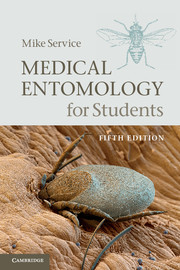Book contents
- Frontmatter
- Contents
- Preface to the first edition
- Preface to the second edition
- Preface to the third edition
- Preface to the fourth edition
- Preface to the fifth edition
- Acknowledgements
- 1 Introduction to mosquitoes (Culicidae)
- 2 Anopheline mosquitoes (Anophelinae)
- 3 Culicine mosquitoes (Culicinae)
- 4 Black flies (Simuliidae)
- 5 Phlebotomine sand flies (Phlebotominae)
- 6 Biting midges (Ceratopogonidae)
- 7 Horse flies (Tabanidae)
- 8 Tsetse flies (Glossinidae)
- 9 House flies and stable flies (Muscidae) and latrine flies (Fanniidae)
- 10 Flies and myiasis
- 11 Fleas (Siphonaptera)
- 12 Sucking lice (Anoplura)
- 13 Bedbugs (Cimicidae)
- 14 Triatomine bugs (Triatominae)
- 15 Cockroaches (Blattaria)
- 16 Soft ticks (Argasidae)
- 17 Hard ticks (Ixodidae)
- 18 Scabies mites (Sarcoptidae)
- 19 Scrub typhus mites (Trombiculidae)
- 20 Miscellaneous mites
- Appendix Names of some chemicals and microbials used in vector control (with common trade names in parentheses)
- Glossary of common terms relevant to medical entomology
- Select bibliography
- Index
- Plate section
- References
19 - Scrub typhus mites (Trombiculidae)
Published online by Cambridge University Press: 05 June 2012
- Frontmatter
- Contents
- Preface to the first edition
- Preface to the second edition
- Preface to the third edition
- Preface to the fourth edition
- Preface to the fifth edition
- Acknowledgements
- 1 Introduction to mosquitoes (Culicidae)
- 2 Anopheline mosquitoes (Anophelinae)
- 3 Culicine mosquitoes (Culicinae)
- 4 Black flies (Simuliidae)
- 5 Phlebotomine sand flies (Phlebotominae)
- 6 Biting midges (Ceratopogonidae)
- 7 Horse flies (Tabanidae)
- 8 Tsetse flies (Glossinidae)
- 9 House flies and stable flies (Muscidae) and latrine flies (Fanniidae)
- 10 Flies and myiasis
- 11 Fleas (Siphonaptera)
- 12 Sucking lice (Anoplura)
- 13 Bedbugs (Cimicidae)
- 14 Triatomine bugs (Triatominae)
- 15 Cockroaches (Blattaria)
- 16 Soft ticks (Argasidae)
- 17 Hard ticks (Ixodidae)
- 18 Scabies mites (Sarcoptidae)
- 19 Scrub typhus mites (Trombiculidae)
- 20 Miscellaneous mites
- Appendix Names of some chemicals and microbials used in vector control (with common trade names in parentheses)
- Glossary of common terms relevant to medical entomology
- Select bibliography
- Index
- Plate section
- References
Summary
There are more than 2000 species of trombiculid mites in many genera, but only about 20 species commonly attack people. The family Trombiculidae has a more or less worldwide distribution, but the medically most important species, such as Leptotrombidium deliense, L. akamushi and L. fletcheri, which are vectors of scrub typhus (Orientia tsutsugamushi), are found in Asia, the Pacific regions and the northeast coast of Australia.
Other trombiculid mites in many parts of the world cause itching and a form of dermatitis known as scrub itch, autumnal itch or trombidiosis. In northern Europe larvae of Neotrombicula autumnalis (harvest mites) and in North America and parts of Central and South America larvae of Eutrombicula alfreddugesi (red bugs) commonly attack people and cause considerable discomfort. Some authors place both these species in the genus Trombicula.
External morphology
Adults and nymphs
Adults are small (1–2 mm), usually reddish, and covered dorsally and ventrally with numerous feathered hairs giving them a velvety appearance. The four pairs of legs end in paired claws. The body is distinctly constricted between the third and fourth pairs of legs, giving it an outline resembling a figure of eight. Palps and mouthparts project in front of the body and are clearly visible (Fig. 19.1).
Nymphs resemble the adults but are smaller (0.5–1.0mm) and the body is less densely covered with feathered hairs.
Neither adults nor nymphs are of direct medical importance; they do not bite humans or animals but feed on small arthropods and their eggs. Only the larvae are parasitic and hence disease vectors.
- Type
- Chapter
- Information
- Medical Entomology for Students , pp. 260 - 268Publisher: Cambridge University PressPrint publication year: 2012



